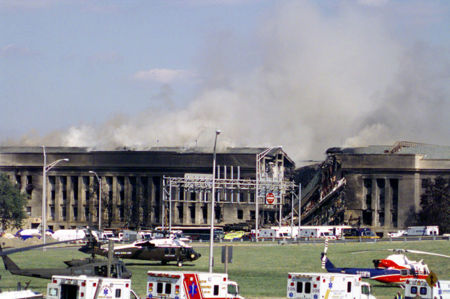Terrorism: Difference between revisions
imported>Charles Sandberg No edit summary |
imported>Charles Sandberg No edit summary |
||
| Line 2: | Line 2: | ||
'''Terrorism''' refers to any act, usually violent, meant to coerce behavior for political ends. Terrorism is used to bring fear to the population to obtain a certain political objective. Terrorism has been practiced by both right-wing and left-wing political organizations, nationalistic and religious groups, revolutionaries, as well as armies, police, and intelligence services. | '''Terrorism''' refers to any act, usually violent, meant to coerce behavior for political ends. Terrorism is used to bring fear to the population to obtain a certain political objective. Terrorism has been practiced by both right-wing and left-wing political organizations, nationalistic and religious groups, revolutionaries, as well as armies, police, and intelligence services. | ||
Since terrorist groups are generally small in numbers and have little resources available, terrorists rely on dramatic and destructive hit-and-run acts of violence to get the attention of the general population. Terrorists seek to obtain the influence among the population through the publicity of this violence. | |||
==Definition== | ==Definition== | ||
Revision as of 13:52, 17 June 2007
Terrorism refers to any act, usually violent, meant to coerce behavior for political ends. Terrorism is used to bring fear to the population to obtain a certain political objective. Terrorism has been practiced by both right-wing and left-wing political organizations, nationalistic and religious groups, revolutionaries, as well as armies, police, and intelligence services.
Since terrorist groups are generally small in numbers and have little resources available, terrorists rely on dramatic and destructive hit-and-run acts of violence to get the attention of the general population. Terrorists seek to obtain the influence among the population through the publicity of this violence.
Definition
Terrorism has many definitions. Based on a survey of leading academics, there are at least 109 different definitions of terrorism (Schmidt & Jongman 1988). A compiled analysis of this survey identified the following recurring elements:
- Violence, force (83.5%)
- Political (65%)
- Fear, emphasis on terror (51%)
- Threats (47%)
- Psychological effects and anticipated reactions (41.5%)
- Discrepancy between the targets and the victims (37.5%)
- Intentional, planned, systematic, organized action (32%)
- Methods of combat, strategy, tactics (30.5%)
The common elements of terrorism, as stated by Ganor (2002), are “the use of, or threat to use, violence”; “the goal is to attain political objectives”; and “the targets of terrorism are civilians”.
The most widely accepted legal definition is defined in Title 22 of the United States Code, Section 2656f(d), which states: The term ‘terrorism’ means premeditated, politically motivated violence perpetrated against non-combatant targets by sub-national groups or clandestine agents, usually intended to influence an audience.
State Sponsorship of Terrorism
There are basically three categories of state sponsorship of terrorism. These are as follows:
1. States supporting terrorism – “states that support terrorist organizations, providing financial aid, ideological support, military or operational assistance” (Ganor 2002)
2. States operating terrorism – “states that initiate, direct and perform terrorist activities through groups outside their own institutions” (Ganor 2002)
3. States perpetrating terrorism – “states perpetrating terrorist acts abroad through their own official bodies” (Ganor 2002) or perpetrating terrorist acts domestically (i.e. within its own borders).
Types of Terrorism
- Bio Terrorism – the release of germ or virus agents
- Chemical Terrorism – the release of poisonous gases
- Cyber Terrorism – the electronic attack on critical infrastructure
- Nuclear Terrorism – the use of nuclear materials in a terrorist attack
References & Readings
- Conference of Foreign Ministers (2005). Kuala Lumpur Declaration on International Terrorism at [1]
- Boyle, G. (2002). Theories of Justification and Political Violence: Examples from Four Groups. Terrorism and Political Violence. 14(2).
- Brynen, R. (1990). Sanctuary and Survival: The PLO in Lebanon. Westview Press.
- Committee of Privy Counsellors (2004, July). Review of Intelligence on Weapons of Mass Destruction. United Kingdom House of Lords.
- Cragin, K. & Daly, S. (2004). The Dynamic Terrorist Threat, An Assessment of Group Motivations and Capabilities in a Changing World. Project Air Force.
- Crelinsten, R. (2002). Analysing Terrorism and Counter-terrorism: A Communications Model. Terrorism and Political Violence. 14(2).
- Emerson, S. (1997, August 4). The terrorist infrastructure. Wall Street Journal.
- Ganor, B. (2002). Defining Terrorism: Is One Man’s Terrorist Another Man’s Freedom Fighter? Police Practice and Research. 3(4).
- Hookway, J. (2002). Terrorist Bombings Hit Philippines --- Series of Weekend Explosions Kill 10 People, Highlighting Militants' Threat to Region. Wall Street Journal.
- Hufbauer, G., Schott, J. & Oegg, B. (2005). Policy Brief 01-11: Using Sanctions to Fight Terrorism at [2]
- Israeli, R. (2002). A Manual of Islamic Fundamentalist Terrorism. Terrorism and Political Violence. 14(4).
- Israeli, R. (2002). Western Democracies and Islamic Fundamentalist Violence. Terrorism and Political Violence. 12(4).
- Lenzer, R. & Vardi, N. (2004). Terror Inc.. Forbes.
- National Commission on Terrorism (2005). Countering the Changing Threat of International Terrorism at [3]
- Nedoroscik, J. (2002). Extremist Groups in Egypt. Terrorism and Political Violence. 14(2).
- Perl, R. (2005). Terrorism, The Media, and the Government: Perspectives, Trends, and Options for Policymakers. CRS Issue Brief at [4]
- Post, J., Sprinzak, E. & Denny, L. (2003). The Terrorist in Their Own Words: Interviews with 35 Incarcerated Middle Eastern Terrorists. Terrorism and Political Violence. 15(1).
- Sedgwick, M. (2004). Al-Qaeda and the Nature of Religious Terrorism. Terrorism and Political Violence. 16(4).
- Schmidt, A. & Jongman, A. (1988). Political Terrorism. SWIDOC and Transaction Books.
- Trimble, D. (2004). The Lesson of Northern Ireland. Wall Street Journal.
- Tucker, D. (2001). Chapter Seven: Combating International Terrorism. The Terrorism
- Threat and U.S. Government Response: Operational and Organizational Factors. USAF Institute for National Security Studies.
- Weinberg, L., Pedahzur, A. & Hirsch-Hoefler, S. (2004). The Challenges of Conceptualizing Terrorism. Terrorism and Political Violence. 16(4).
- Wentz, L. (2002). Lessons From Kosovo: The KFOR Experience. CCRP.
